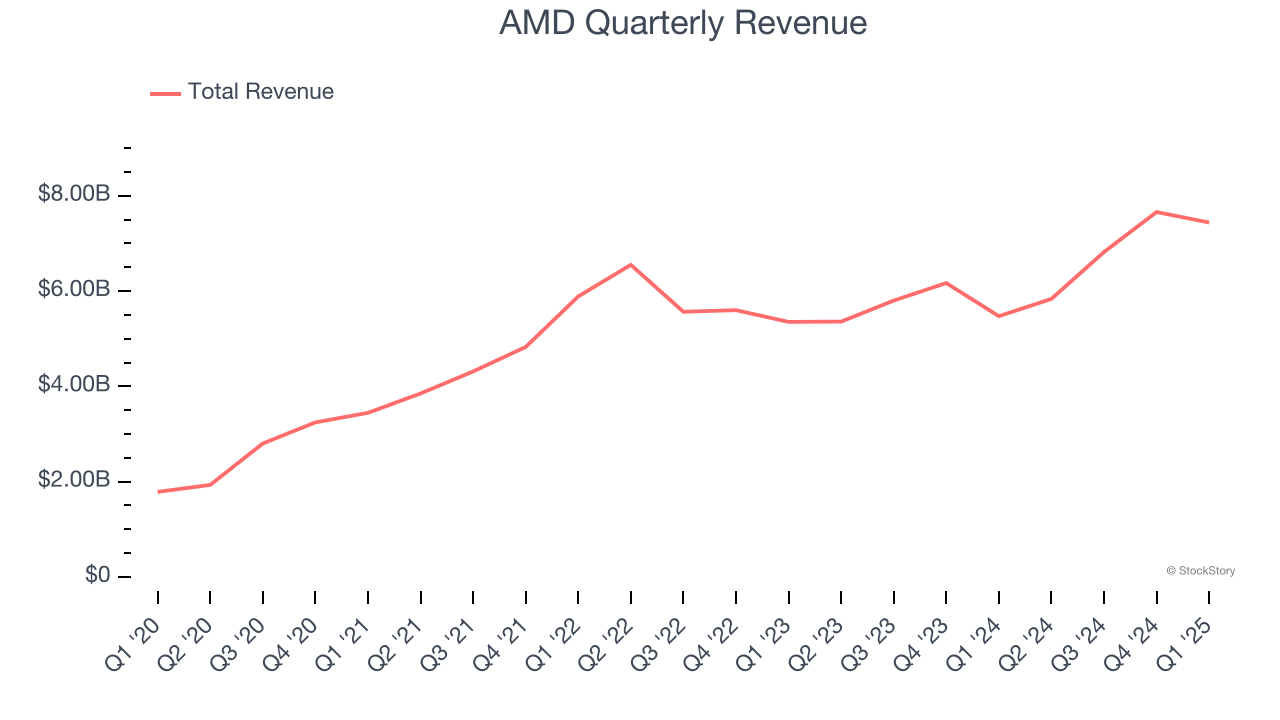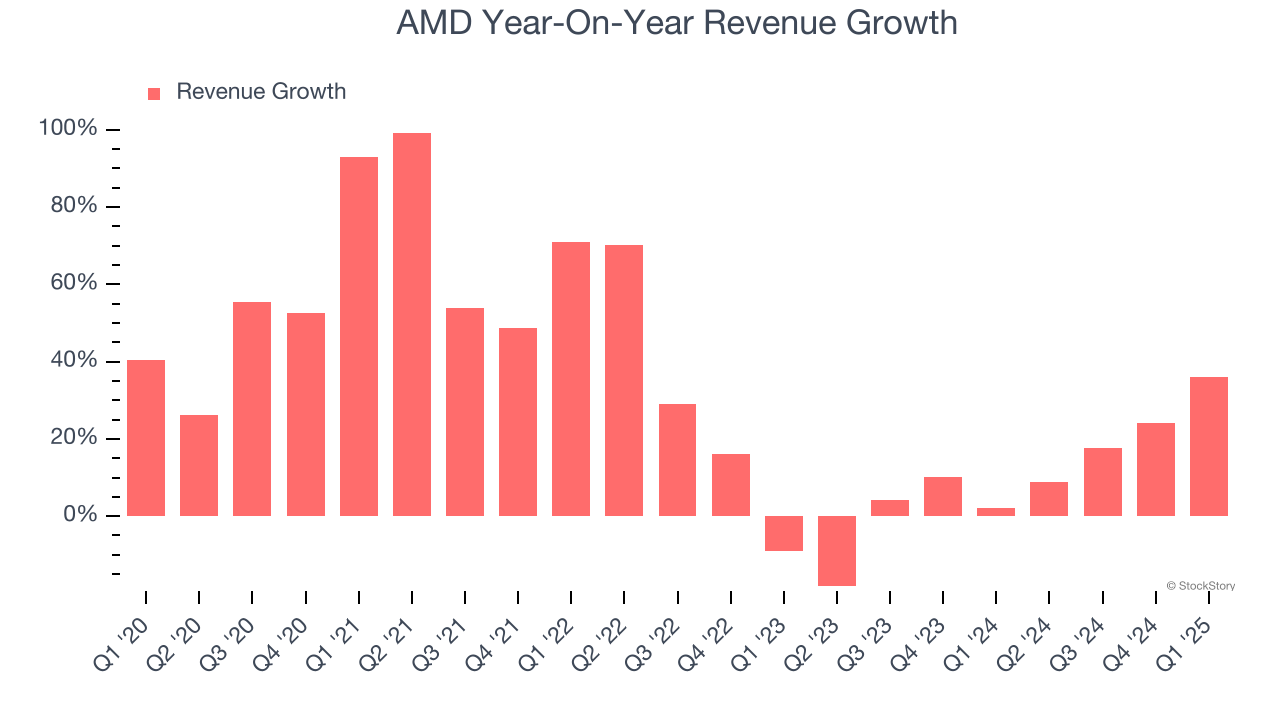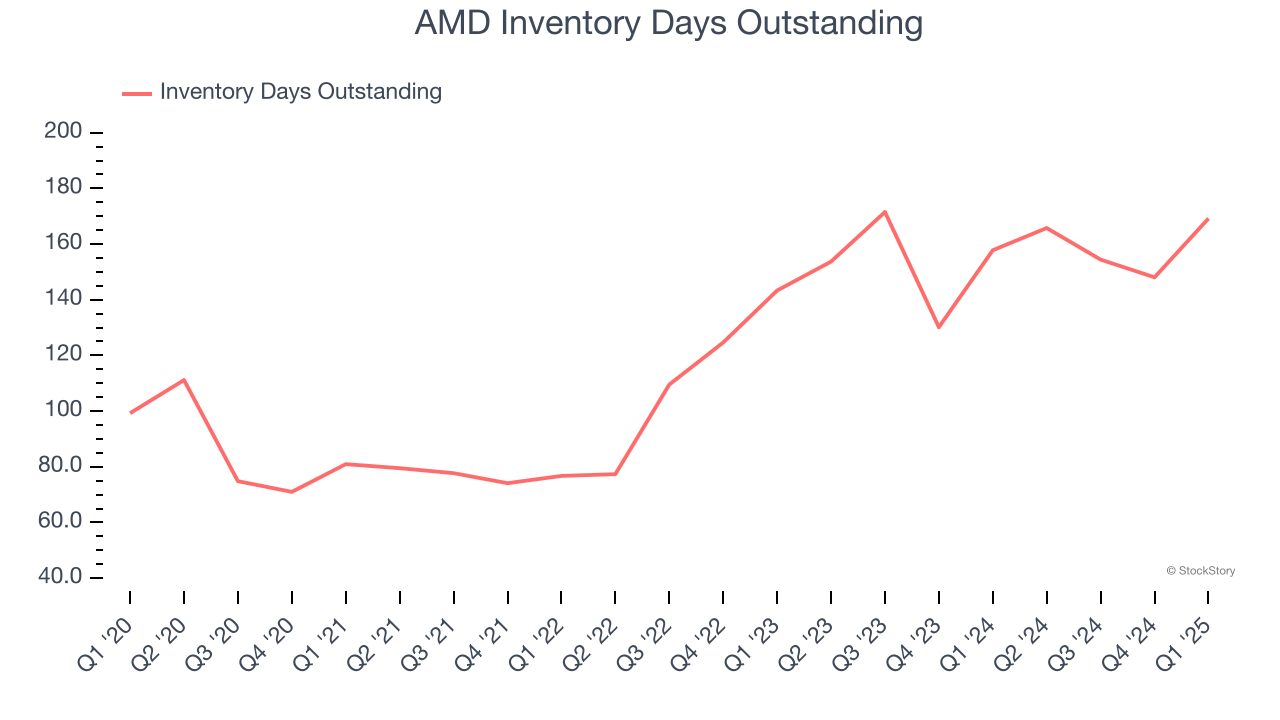
Computer processor maker AMD (NASDAQ: AMD) beat Wall Street’s revenue expectations in Q1 CY2025, with sales up 35.9% year on year to $7.44 billion. Guidance for next quarter’s revenue was better than expected at $7.4 billion at the midpoint, 1.3% above analysts’ estimates. Its non-GAAP profit of $0.96 per share was 2.8% above analysts’ consensus estimates.
Is now the time to buy AMD? Find out by accessing our full research report, it’s free.
AMD (AMD) Q1 CY2025 Highlights:
- Revenue: $7.44 billion vs analyst estimates of $7.13 billion (35.9% year-on-year growth, 4.4% beat)
- Adjusted EPS: $0.96 vs analyst estimates of $0.93 (2.8% beat)
- Adjusted EBITDA: $1.95 billion vs analyst estimates of $1.57 billion (26.3% margin, 24.1% beat)
- Revenue Guidance for Q2 CY2025 is $7.4 billion at the midpoint, above analyst estimates of $7.30 billion
- Operating Margin: 10.8%, up from 0.7% in the same quarter last year
- Free Cash Flow Margin: 9.8%, up from 6.9% in the same quarter last year
- Inventory Days Outstanding: 169, up from 148 in the previous quarter
- Market Capitalization: $162.6 billion
“We delivered an outstanding start to 2025 as year-over-year growth accelerated for the fourth consecutive quarter driven by strength in our core businesses and expanding data center and AI momentum,” said Dr. Lisa Su, AMD chair and CEO.
Company Overview
Founded in 1969 by a group of former Fairchild semiconductor executives led by Jerry Sanders, Advanced Micro Devices (NASDAQ: AMD) is one of the leading designers of computer processors and graphics chips used in PCs and data centers.
Sales Growth
Examining a company’s long-term performance can provide clues about its quality. Any business can put up a good quarter or two, but the best consistently grow over the long haul. Luckily, AMD’s sales grew at an incredible 30.8% compounded annual growth rate over the last five years. Its growth beat the average semiconductor company and shows its offerings resonate with customers, a helpful starting point for our analysis. Semiconductors are a cyclical industry, and long-term investors should be prepared for periods of high growth followed by periods of revenue contractions.

We at StockStory place the most emphasis on long-term growth, but within semiconductors, a half-decade historical view may miss new demand cycles or industry trends like AI. AMD’s annualized revenue growth of 9.7% over the last two years is below its five-year trend, but we still think the results suggest healthy demand. 
This quarter, AMD reported wonderful year-on-year revenue growth of 35.9%, and its $7.44 billion of revenue exceeded Wall Street’s estimates by 4.4%. Beyond the beat, this marks 7 straight quarters of growth, showing that the current upcycle has had a good run - a typical upcycle usually lasts 8-10 quarters. Company management is currently guiding for a 26.8% year-on-year increase in sales next quarter.
Looking further ahead, sell-side analysts expect revenue to grow 16.3% over the next 12 months, an improvement versus the last two years. This projection is particularly healthy for a company of its scale and suggests its newer products and services will fuel better top-line performance.
Here at StockStory, we certainly understand the potential of thematic investing. Diverse winners from Microsoft (MSFT) to Alphabet (GOOG), Coca-Cola (KO) to Monster Beverage (MNST) could all have been identified as promising growth stories with a megatrend driving the growth. So, in that spirit, we’ve identified a relatively under-the-radar profitable growth stock benefiting from the rise of AI, available to you FREE via this link.
Product Demand & Outstanding Inventory
Days Inventory Outstanding (DIO) is an important metric for chipmakers, as it reflects a business’ capital intensity and the cyclical nature of semiconductor supply and demand. In a tight supply environment, inventories tend to be stable, allowing chipmakers to exert pricing power. Steadily increasing DIO can be a warning sign that demand is weak, and if inventories continue to rise, the company may have to downsize production.
This quarter, AMD’s DIO came in at 169, which is 52 days above its five-year average, suggesting that the company’s inventory has grown to higher levels than we’ve seen in the past.

Key Takeaways from AMD’s Q1 Results
We enjoyed seeing AMD beat analysts’ revenue expectations this quarter. We were also glad its adjusted operating income outperformed Wall Street’s estimates. On the other hand, its inventory levels materially increased. Overall, this print had some key positives. The stock traded up 4.3% to $102.82 immediately after reporting.
AMD may have had a good quarter, but does that mean you should invest right now? If you’re making that decision, you should consider the bigger picture of valuation, business qualities, as well as the latest earnings. We cover that in our actionable full research report which you can read here, it’s free.

